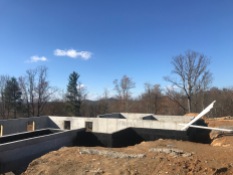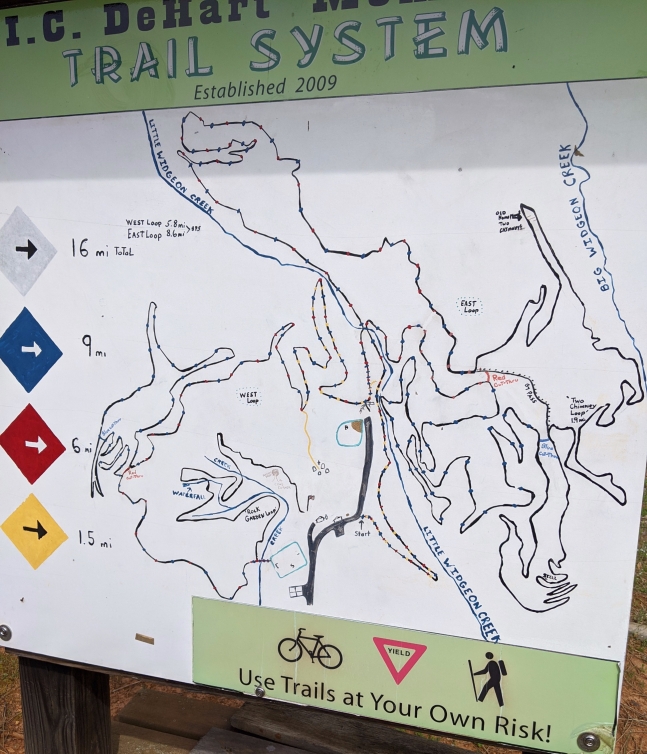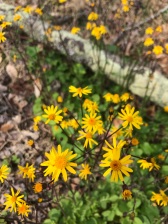The first flaw in our new home build was a big one! Before we broke ground, I had flagged off several possibilities for how to situate the home on our house site. I met with the builder, and explained that we’d chosen the option with a north-northeast direction (the stakes with two flags)—NOT the direct north-south orientation (the stakes with one flag). Within a couple of days, the foundation sub-contractor had come in and carefully pinpointed the exact corners of the house footprint. I was so excited to go see, with precision, the view out my bedroom window, and the location of the front porch! But as I stood in the field on the “front porch,” it didn’t feel quite right. I pulled out my compass. Sure enough, the house was oriented on a due north-south direction. He’d used the wrong set of stakes!
Thankfully, no footings had been dug, no concrete had been poured. The contractor owned his mistake, and paid the sub to come back and spend another day laying out the right footprint for the house. Four lightning-quick weeks later—after the basement had been dug, the footers poured, and the basement walls poured—I stood on the front porch space and thought, “What if I hadn’t caught this mistake? What if we discovered it now, and had to rotate the entire foundation of this house twenty-two and a half degrees towards the east? It wouldn’t be happening—unless I had a magic wand!”
We were a week and a half into pandemic isolation at that time, and everything was wrong. I couldn’t visit my parents’ house. My carefully-laid plans were trashed. I was forced to interact with people through a screen. My introverted batteries were drained by the incessant noise of a house full of children. I watched helplessly as my remaining months of sabbatical leave were being hijacked by increasing family and work demands. Outwardly, I tried to be positive. Inwardly, I was a little boy who, halfway through enjoying a banana split, found that someone had replaced the bananas with dill pickles, and was forced to keep eating it. I was angry, bitter and resentful. My recurring thought was, “No! This can’t be happening!” But it was. And I couldn’t do a thing about it.
I also couldn’t do anything about my “No!” orientation to this new normal. I wanted to change my heart—to learn to say, “Yes!” to what was happening—but couldn’t muster the willpower. In my heart-of-hearts, I knew this change was essential if I was to survive this pandemic without going off my rocker! So I went looking for the magic mystery pill which might move my heart. I prayed the Serenity Prayer: “God grant me the serenity to accept the things I cannot change, the courage to change the things I can…” Nothing happened. I doubled-down on my daily, twenty-minute centering prayer sessions. Nothing changed. I opened my Bible, looking for a word of grace that would open the skies of my soul to rainbows and sunshine. Nothing. I even added a second day of fasting for the week (one of my Lenten disciplines). Nothing changed. The ground of my being was as firmly fixed as a two-year-old being told to share his toys: “NO! I refuse to accept this! I will not surrender! I will NOT give in! I demand my old life back!”
Then one Wednesday it happened. Sometime mid-morning, as I was responding to some urgent emails, my youngest son came in asking me to help him with his spelling. “Sure,” I said. After we did the spelling lesson, he asked, “Could you help me with these long division problems?” “Yeah, sure.” Later, as I was helping my kids make lunch, it occurred to me: Something is different here. My heart had shifted. I found myself embracing reality as it was—not as I wanted it to be. I felt joy as it dawned on me: “My whole orientation has changed. After weeks of, ‘No!’ I am suddenly saying, ‘Yes!’ to what is.”
The foundation of my life shifted that day. I’d been helpless to reorient the house of my life. And yet, by a power greater than myself, I now found myself on new footings, with my whole approach and perspective changed. I had moved from opposition to acceptance, from pessimism to trust, from despair to hope, from self-centeredness to love. Jesus said, “If you have faith the size of a mustard seed, you will say to this mountain, ‘Move from here to there,’ and it will move; and nothing will be impossible for you” (Matthew 17:20). I like to think I had commanded the mountain of my own life to be moved, but that wasn’t true. It was God’s doing. But the mustard seed of my faith did play a part. I longed for a new orientation, and gave God space each day to work at making that happen. Through spiritual practices, I was giving God the time to do some demolition in the basement of my life, and to do the impossible: to dig new footers. God could certainly do that without my efforts–whether instantly, or over time. It’s God’s work, but still…it also involves me.
Once upon a time, I did spiritual activities because they made me feel good. (To a certain degree, that’s still true.) But I’m understanding more and more that prayer, scripture reading, meditation, etc. are less about the immediate results. These practices deepen my capacity for grace—a grace which can build a foundation that’s firm and solid, and yet flexible, nimble and resilient. It can even take a poorly positioned life, uproot it, and reorient it in such a way that it will stand through the storm, and even dance in the rain. Sure, I still have moments when I shift back into old ways. But in the end, grace prevails.








 It called to me, this tiny burst of color amid the debris of dried leaves and lifeless twigs. It seemed to say, “Pay attention.” Like a hushed herald of spring, this silent sentinel standing watch by the tomb beckoned me to see what I was too quick to tromp past in my determination to find a worthy destination. Suddenly a veil was lifted from our eyes. Kim discovered periwinkles making glacial tracks in the sandy stream bottom. I saw fresh-green fiddleheads emerging from the waste of spent ferns. Younger-son uncovered a crawdad hiding beneath a rock. Middler-son eventually grew bored of waiting for us down the path, and came back to find us. He, too, joined the fun of exploring the quiet revolution happening right under our noses.
It called to me, this tiny burst of color amid the debris of dried leaves and lifeless twigs. It seemed to say, “Pay attention.” Like a hushed herald of spring, this silent sentinel standing watch by the tomb beckoned me to see what I was too quick to tromp past in my determination to find a worthy destination. Suddenly a veil was lifted from our eyes. Kim discovered periwinkles making glacial tracks in the sandy stream bottom. I saw fresh-green fiddleheads emerging from the waste of spent ferns. Younger-son uncovered a crawdad hiding beneath a rock. Middler-son eventually grew bored of waiting for us down the path, and came back to find us. He, too, joined the fun of exploring the quiet revolution happening right under our noses.
